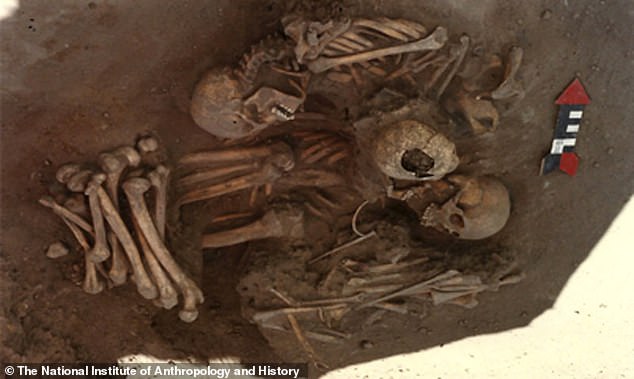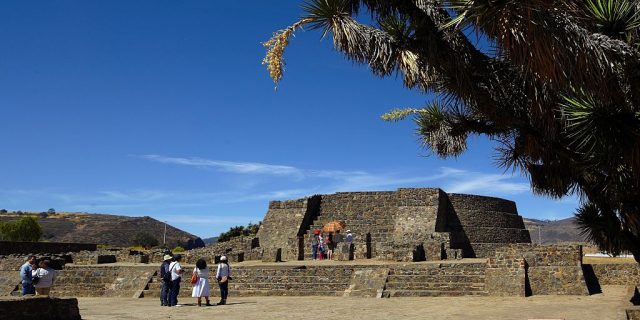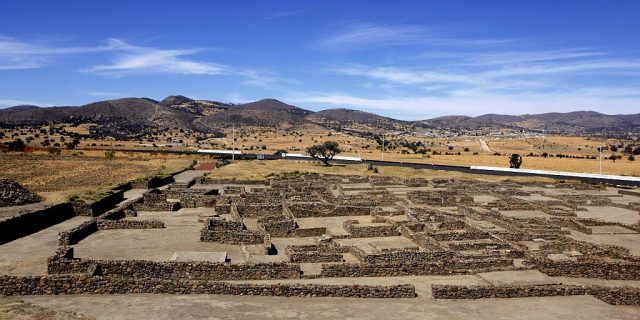A shocking ancient Aztec massacre comes to light in Mexico City. Human remains have been found at an archaeological site at Zultépec, revealing mass slaughter of Aztecs by Spanish conquistadors. The victims were women and children.
This grisly scene, dating to the early 1520s, was revealed by INAH (the National Institute of Anthropology and History). They’ve dug the area for decades, exploring how Aztec culture fell under the onslaught of arch conqueror Hernán Cortés.

Quoted by Mexico News Daily, site director Enrique Martínez Vargas refers to a main thoroughfare stretching 120 meters. It was here that “skeletons of a dozen women were found who appeared to be ‘protecting’ the bones of 10 children”. It isn’t known what sex they were, only their ages… between 5 and 6.
The positioning indicates the sheltering women were turned inwards, possibly shielding the innocents. Their graves appear to have been dug quickly post-demise.

Martínez believes this is evidence of an attack mentioned in Bernal Díaz del Castillo’s ‘The True History of the Conquest of New Spain’ (1632), as reported by Mexico News Daily. Another source is Cortés’ own ‘Third Letter of Relation to the Emperor Carlos V’ (1522).
Led by Cortés’ lieutenant Gonzalo de Sandoval, the massacre forms an alarming chapter in the history of Spanish conquest. Between 1519-21 Aztec territory was breached with extreme violence. Other factors such as traveling diseases also played a part in the conflict, which culminated in the taking of ancient capital Tenochtitlan.
So why did such a brutal act take place? The answer lies in another name for Zultépec… Tecoaque, translating from Nahuatl as “the place where they ate them”.

The Daily Mail describes the Conquistador attack as a “retaliatory raid”. 1520 saw a convoy enter what’s now Mexico. The Guardian writes it was made up of “15 male Spaniards, 50 women and 10 children, 45 foot soldiers who included Cubans of African and Indigenous descent”. An additional 350 Indigenous allies completed the party.
Interestingly, they were connected to Pánfilo de Narváez, a conquistador sent on the order of Cuba’s governor Diego Velázquez de Cuéllar. The official wanted Narváez to intercept Cortés, who hadn’t asked permission to move in.

Whether the convoy was there to stop Cortés or otherwise, they wound up encountering Aztecs, namely the Acolhua people. The men, women and children suffered a horrific fate.
The Daily Mail writes the visitors were “kept prisoner in doorless cells, where they were fattened up for ritual sacrifices”.

Over a period of 8 months the captives met their end. Skeletal markings show how meat was carved away. Skulls were attached to racks and other bones became trophies.
It was horrendous, yet imbued with spiritual significance. The Guardian writes about how one of the men was destroyed and his remains burned as a grim tribute to the gods. The Mail reports that several thousand Aztecs attended Tecoaque, to take part in the rituals.

Animals accompanying the convoy were consumed. Though the Aztecs avoided eating Spanish-brought pigs, who were effectively alien creatures to them.
Aztec defences proved no match for Gonzalo de Sandoval, who struck in early 1521. And so one terrible event happened in revenge over another. Temples were set on fire and statues wrecked.
Martínez and colleagues found evidence of concealment by the Acolhua. They hid the Europeans’ remains and personal possessions in places like wells. Seems they were fully aware of the potential consequences for their actions.
The team from INAH believe Zultépec/Tecoaque represents a pivotal moment in Cortés plans and the Indigenous response to them.
Another Article From Us: Very Rare Mummies with Gold Tongues Discovered in Egyptian Temple
The latest find may be chilling but it also presents itself at a crucial time. 2021 is the 500th anniversary of Tenochtitlan’s capture. A stark reminder of times past is needed for the milestone. And they don’t come much starker than this…
